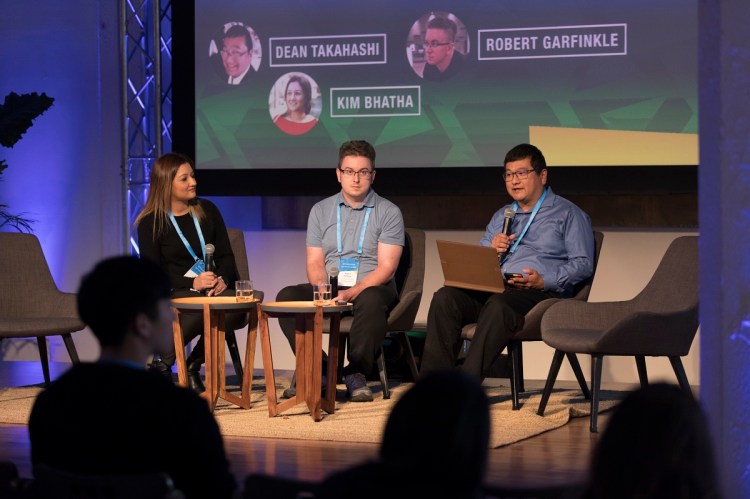Acquiring users for mobile games isn’t the sexiest part of the game industry. But it’s a critical one. And so I was happy to get caught up on the subject of the highly automated and strategic process of acquiring new users through mobile advertising campaigns.
I moderated a panel on the subject at Adjust’s Mobile Spree event in San Francisco. It got a lot of attention, as mobile gaming is a $70 billion market, and it is the biggest part of gaming. And games account for 10% of time spent on mobile devices, but 74% of revenue in the mobile game industry.
And acquiring new gamers isn’t easy for mobile games that have been around for a while. User acquisition managers are dealing with the automation of the industry, and they’re busy weighing how much effort to put into re-engagement versus getting new users. And the market is changing, with the rise of hyper-casual games, where players spend a short amount of time on some very casual apps.
My panelists included Robert Garfinkle, senior user acquisition manager at Big Huge Games, and Kim Bhatha, senior lead for growth marketing at Zynga.
Here’s an edited transcript of our interview.
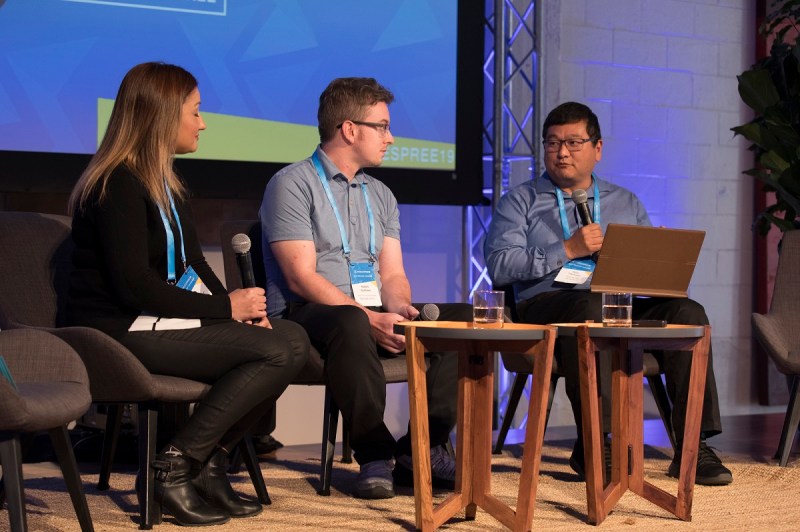
Above: Left to right: Kim Bhatha of Zynga, Robert Garfinkle of Big Huge Games, and Dean Takahashi of GamesBeat.
Robert Garfinkle: I’ve been in the gaming space about seven years. I got my start at Elex, which was a Beijing-based strategy developer. Since then I’ve been around to Gameloft and Netmarble and Nexon for the last three and a half years. Now I’ve made the transition to a Nexon-owned development studio, Big Huge Games.
Kim Bhatha: I’ve been in gaming for about nine years. I’ve been at Zynga about four and a half years. Through my time at Zynga I’ve touched different genres of games, from FarmVille to poker to Words With Friends.
GamesBeat: Mobile gaming is a $70 billion market now, the biggest part of games. I was looking at some interesting stats. Apparently 10 percent of time is spent on mobile games, but games account for 74 percent of the revenue in the mobile industry. Games lead the way in trends. An initial question would be, user acquisition in this space has always been changing. I wonder if you could describe what your job was like a few years back, what you remember about it, versus what user acquisition is like now.
Garfinkle: Diving right into how it’s changed over the years, there’s a lot more marketing automation. There’s a lot less manual verification that this install came from this publisher at the right rate. There are a lot fewer disputes and a lot more checking on the mobile measurement partner (MMP) side for fraud, more verification in most regards of the quality of the installs you’re getting. It’s also changed a lot in terms of scale. There are a lot more users in the audience now, and a lot more diversity in what qualified users look like.
Bhatha: I’ve definitely seen a lot of changes over the last couple of years. I remember grinding and segmenting my audiences and countries and ages. So many different ways you could segment your campaigns. Just optimizing toward an app install. Recently, like Rob mentioned, it’s moving more toward automation and machine learning. There’s less visibility, less segmentation, and targeting broader, larger groups of audience, as well as focusing more on post-install events.
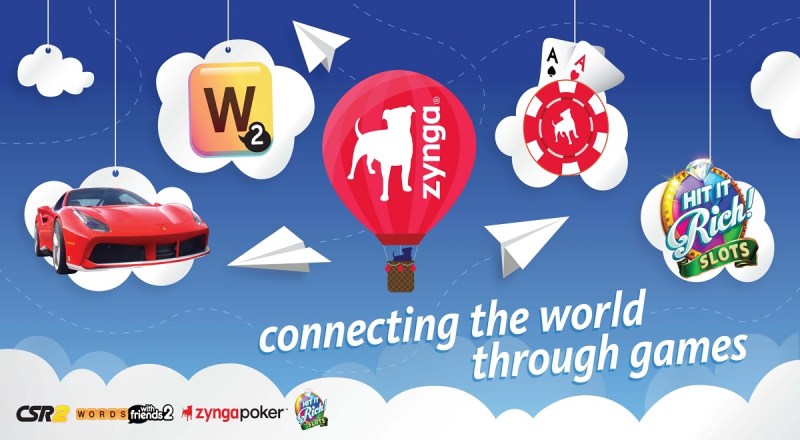
Above: Zynga
GamesBeat: What do you think you’re going to do so you don’t get automated out of a job?
Bhatha: You need to strategize. That’s why UA managers will still play a huge role, I think.
Garfinkle: You can’t really rest on your laurels, but I think by increasing the integration that UA managers have with product, there will always be a lot of leverage we have to start growing further.
GamesBeat: We were brainstorming earlier about what’s changed in the game market over the last year, the last couple years, and we zeroed in on hypercasual games. The best way to describe these games could be the games you play while you’re on hold on the phone. Or when you blow your nose on a Kleenex and throw it away, that Kleenex is the hypercasual game. What would you say about how this has affected user acquisition?
Garfinkle: What it is, it’s really grown the overall audience size in gaming, well beyond what it used to be. You used to have a few million core users in the U.S. market. If you were acquiring an install, it was qualified. It was a user that understood core gaming concepts and was able to play the game that you wanted them to. That’s not so true anymore. There’s a very large new-to-gaming audience that’s being brought in by hypercasual. It remains to be seen if they’re going to start becoming more literate as time goes on.
Bhatha: With hypercasual, it’s not made for a “gamer.” It’s more for 45+, 55+ women playing those types of games. It opened up more inventory for other games to increase their userbase, but at the same time, it also made the market more competitive. It increased the cost.
Garfinkle: It’s cast a very sharp light on the idea that installs equal revenue. It’s very much invalidated the idea that you can just dump installs in a game and have that result in higher aggregate revenue.
GamesBeat: I saw a report from YouAppi out this week that said you pay so much more to just try to retain your users, but retention has been going down, and some of the blame goes toward these hypercasual games. Your game, DomiNations, is in a fairly hardcore genre. It’s almost like you want to sort these people out.
Garfinkle: We have fairly advanced systems for identifying publishers that are delivering less than ideal installs and reducing our market exposure to those.
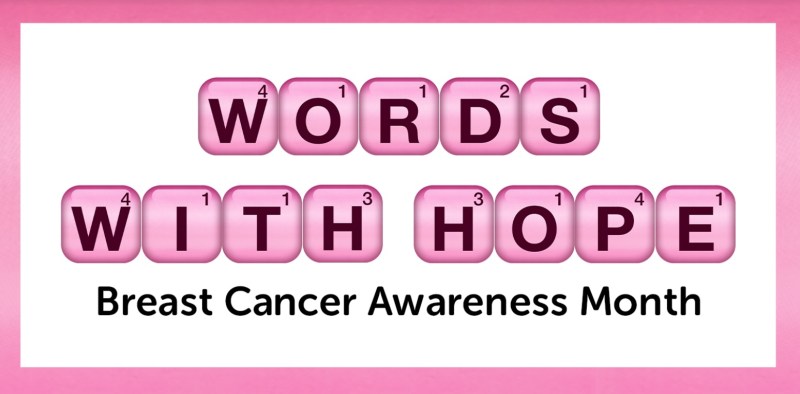
Above: Words With Hope is a Zynga campaign to fight breast cancer.
GamesBeat: Zynga’s games are more casual, though.
Bhatha: Hypercasual is definitely making the market more competitive, but it’s not necessarily the type of users that casual games are looking for. We’re looking for users who will later monetize, and I don’t see the users who are coming in from these types of games as high monetizing users.
GamesBeat: For me, games are always fun because there are so many different crazy things happening. Blizzard stepped in it with the esports player who spoke out about Hong Kong and got banned from Hearthstone esports. It’s been interesting how brands have been chasing after esports, and then they run into the kinds of surprises that can happen, whether it’s racism or sexism or politics. Then there’s AR and VR. AR has a little more relevance to mobile games. Google’s Stadia is also going to have some relevance to mobile. The FTC is looking at loot boxes and gacha mechanics.
I wonder what of these things show up on your radar more. Or do you have a more heads-down approach to doing your job?
Bhatha: I can speak to AR features. In our racing game CSR 2, we released a feature where players were able to take pictures with their dream cars in their driveway, cars they can’t afford in real life. It was a huge success for CSR 2. When it comes to things like Oculus and other devices, it’s more expensive to make games there, but if you can innovate with these types of features in your games that can cater to existing players and keep them engaged, that’s a good step.
Garfinkle: Talking about Google Stadia for a minute, what it represents is a convergence event happening in gaming overall. I believe we’re going to see this over the course of several years. The boundaries between the different consoles and platforms are going to break down. Gaming will be more of a universal experience, shared by your phone and your tablet and your PC and your home console and other sort of ambient devices. That’s going to really change the way we do things, not least of which – prescient, considering we’re at a conference sponsored by Adjust – will be really changing attribution and the way we think about these things.
GamesBeat: There will be a universal pool of users, then.
Garfinkle: Theoretically, yeah.
GamesBeat: Does that have more downstream effects? How would you think about that?
Garfinkle: You mentioned legislative action. There’s talk about loot boxes, for one, but beyond that there are lots of concerns about data privacy and the way in which users are being tracked or analyzed. That’s a question that needs to have some mature discussion, but I don’t know specifically where it will go.
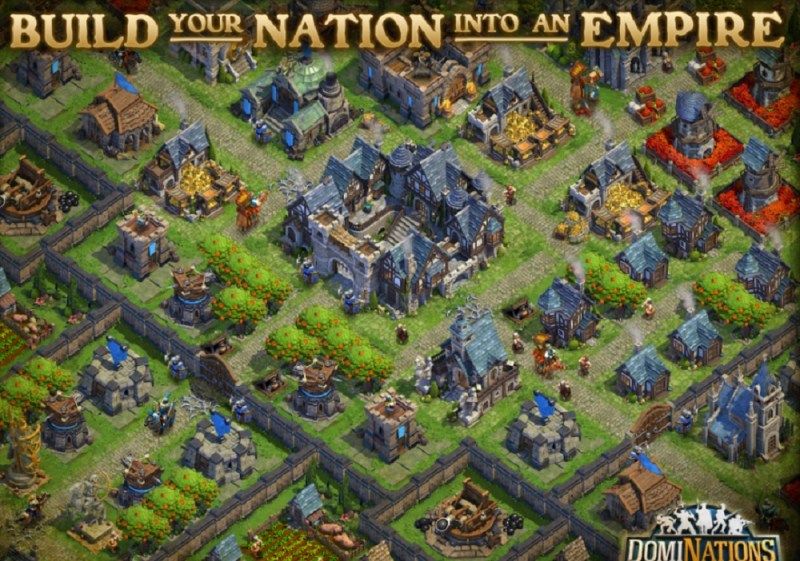
Above: DomiNations from Big Huge Games
GamesBeat: We’re coming into a kind of borderless world. The borders between platforms are coming down. The borders between countries are coming down. That’s why things like Blizzard and Hong Kong become interesting.
For marketers from other disciplines, are there things they can learn from gaming?
Garfinkle: I would suggest that games have always lead on post-install and deep funnel analysis and engagement. If there’s anything that can be gained for other disciplines—if you just study the way that users move through your funnel and understand more about the longer-term journey, I think you’ll gain a lot of knowledge.
Bhatha: That’s what we see. When it comes to differentiating gaming from other verticals, we focus on the lowest cost possible. We have to find the lowest cost users where we can spend more and get the highest returns. We also have to focus on understanding the product and the player base that we’re advertising to. As Rob mentioned, it’s more about understanding the user flow throughout the game. Every event in the game impacts the user journey. They can drop out any time, so we have to be careful to make a product that can retain those users.
GamesBeat: Is influencer marketing coming into your focus?
Bhatha: If you look at kids these days, they’re not watching TV. They’re watching YouTube, and they’re watching influencers. It’s becoming a big part of UA. We’re starting to look into influencer marketing as part of our overall strategy. Google and Facebook are both coming up with products. The only caveat there is measurement. They’re trying to figure out attribution, how we can track these types of campaigns.
Garfinkle: On that measurement topic, there’s a lot of debate back and forth about how you figure out influencer deals. Do you do CPI? That’s the most risk-averse of the models. It’s comfortable for most advertisers. But it’s not something most influencers are interested in. There are mismatched interests when it comes to the business side of influencer marketing. It gets very hard to track.
Bhatha: If you think about giving out promo codes for the game that redeem for something, that’s one thing you can track. But measurement is still very up in the air.

Above: Left to right: Kim Bhatha of Zynga, Robert Garfinkle of Big Huge Games, and Dean Takahashi of GamesBeat.
GamesBeat: Do you see things like Mobcrush affecting the mobile side of the market very much? Is there a barrier between the different markets?
Garfinkle: At least in the west, mobile streaming hasn’t taken off in a major way. I’m not sure if anyone knows precisely why, but it’s much more common in the U.S. and western markets to look at premium games that people are playing and streaming through online outlets like Twitch.
Bhatha: One thing about streaming, you want to make sure that when you’re creating content that make something that allows that to be successful. Minecraft is a good example. It became popular because people were able to share their content. Mobile streaming, as Rob mentioned, it’s not completely there yet, but that would be beneficial when it comes to working more in that area.
GamesBeat: If influencer marketing isn’t the biggest deal to you, what might be a bigger trend that you’re trying to stay on top of?
Bhatha: One thing is pre-registration. That’s coming into play. It was big in Japan, and it’s starting to pick up in western markets as well. Google is offering it and Facebook is coming up with a pre-reg product. That’s one way to reach to your golden cohorts ahead of time and get ahead of the game. But again, I think measurement is a piece to solve for there on Google’s end.
Garfinkle: There are still a few untapped proprietary sources of inventory that aren’t quite at the same technological level as a Facebook or a Google. Reddit has recently come up with a relatively unpolished but functional UA product. There are still a few big reservoirs of users. Twitch, which we were just discussing, seems not to be a major player in mobile UA, but it could potentially be if they put their minds to it.
GamesBeat: We glossed over the competition part of mobile, but I wonder what you think about the different rivals out there that have really aggressive UA strategies, compared to what might be more normal. An example I look at is how Machine Zone, with Game of War, their ads were everywhere. They were on TV. They were mining through everybody they could possibly find who might be interested in strategy games to find that one person who’d spend a zillion dollars with their clan. That changed the nature of market competition.
Bhatha: Bigger companies definitely have a lot of budget to spend. They can outbid the market. But for some of the smaller companies, I can speak to challenges we had in the past. It’s more about focusing on organic growth. What can you do on the ASO side to boost up your ranking with keywords or leverage your current userbase with cross-promotion? Also, keep close relationships with the Google and Apple guys. If you can convince them to do a feature, that produces huge organic growth around launch. Combined with UA, those are key features that can bring tremendous results in terms of growing your game.
Garfinkle: To talk about the specific UA competition side, the competition in the waterfall, buying media unsustainably or at a rate that’s not specifically profitable will eventually stop paying dividends. You can’t continue that strategy forever. It’s incumbent on people who are profit-oriented in the business to weather the storm and find ways of getting more sophisticated about your own methodology toward paying for users that are high-quality. You need to find the right user pools. You can’t just throw your hands up and say, “This is a very competitive season, so I can’t afford these CPIs.” That’s not a valid excuse.

Above: R0obert Garfinkle (left) of Big Huge Games, and Dean Takahashi of GamesBeat.
GamesBeat: What are some predictions you’d have for a year from now in user acquisition?
Bhatha: One prediction would be that Snapchat Games is becoming a thing. There’s a huge potential there to discover. Additionally, just in terms of new UA channels, we’re so focused on Facebook and Google, but these other social channels like TikTok, Pinterest, and Snapchat, they have their own ad inventory. They’re tapping into advertising. I also want to see how 5G resolves some of the issues around streaming.
Garfinkle: Streaming games might become much more prevalent in the next year. The Stadia experiment and 5G might yield results. It’s hard to say right now.
What I do think is happening is that right now there’s a lot of relatively unprofitable investment coming into the gaming market from markets that are much more mature. Japan most prominently, as well as China and Korea, have been trying to find ways to expand the gaming market globally. I think we’ll see another rise of major emerging markets, kind of like what happened in India or Turkey a few years ago. We’ll continue to see this transitional state happen with more and more mobile-first markets.
GamesBeat: How much does fraud affect your calculations?
Bhatha: A lot. Some of the strategies we use at Zynga, we look at the networks we buy our inventory from. We look at the traffic really closely and make sure we stop spending on those channels. Also, we work with a third-party vendor, in addition to Adjust SDK, to provide a fraud detection tool. We layer another partner on top of that to make sure we detect fraudulent installs.
But when it comes to fraud in games, like bot frauds, we have a whole team in place that looks at user behavior in the game to make sure those accounts are deleted once we detect fraudulent activity. We also tune our features in games that can prevent bots and cheaters from exploiting them.
Garfinkle: We also use the Adjust fraud prevention suite. It’s rather good. It’s not entirely 100 percent of everything, because I don’t know if you can have an automated system that catches 100 percent, but by limiting our number of partners and finding partners that are more reliable, it really cuts down on how much waste goes into ad fraud. The industry as a whole has had a moment of realizing that ad fraud exists, identifying ways of combating it, and becoming more sophisticated as a result. I haven’t seen SDK spoofing come back in a way that would be an alarm for me.

Above: DomiNations
Question: Across all verticals, people are very interested in identifying whales and trying to get them to join the cycle of your app. Gaming is where this artform was perfected, and I was wondering if you could go into some of the approaches that are part of finding whales. As gaming has matured, people have become more sensitive to this. They don’t want to pay to win. They’ve become more cognizant of paywalls. Are there strategies or approaches you have to either make those sorts of things less obvious, or make people more comfortable with paying for a game after they downloaded it for free.
Garfinkle: It’s a big question. To unpack things a bit, I think most industries have a different approach for high-value customers versus everyone else. VIP programs exist in gaming just as much as they exist for Las Vegas high rollers, to use one extreme example. Having a custom approach to the way you deal with a customer service request from someone who’s spent thousands of dollars is a prudent thing to do.
More broadly, identifying them is not much of an issue. You can spot a high-value user relatively quickly. Finding out where they live in terms of advertising toward them is extremely difficult, though, and something that the major technology partners understand very well at this point. You can go and generate campaigns through things like lookalike audiences as a way of trying to get more high-value users. But it’s not possible to just put a hook out and catch one.
Bhatha: We have similar tactics. We use lookalike VIPs and try to acquire similar audiences. But in terms of people—if they left the game for some reason, we put a budget toward re-engagement. Re-engagement is a big part of the UA strategy at Zynga at the moment. We want to make sure we keep these players in the game.
GamesBeat: I liked the research that USC’s Dmitri Williams did on social whales, how there’s a class of person who’s sort of the life of the party at the bar. They cause a lot of other people to come in and spend money. I don’t know how much you also pay attention to these types of people, who may not spend a lot of money themselves, but they cause a lot of money to be spent.
Garfinkle: In our main strategy game, if you’re an alliance leader, you get rewarded based on how active your whole alliance is. That’s our solution to it. It incentivizes leadership within the user community.
Bhatha: When it comes to Zynga, I think more about celebrity endorsements. Words With Friends has been associated with different celebrities. We’re not necessarily spending within the game, but it’s a good source for us to bring users to the game itself who follow those people, especially with things like our campaign for breast cancer awareness, which has involved a lot of celebrities.
